Final report for FS23-347
Project Information
Research, breeding, selection and seed production work with squash in the Southeast has the potential to improve the pest resistance, disease resistance, quality and productivity of varieties available to Southeast growers.
In this project we researched several kinds of summer and winter squash, with goals of identifying existing varieties that are better suited to Southeast conditions, and of creating new ones. We are seeking varieties that thrive, produce, and keep well in our hot, humid weather and can withstand the pest and disease pressures we experience here. They should also have good eating quality and be easy to manage and harvest.
Summer Squash
In 2023 we screened 14 varieties of Cucurbita moschata-species summer squash and 18 varieties of Cucurbita pepo-species summer squash. In 2024 we did breeding trials of several new populations generated in 2023, as well as some small follow-up screenings. We especially looked for varieties with resistance to vine borer, downy mildew, and plectosporium.
Winter Squash
With winter squash, where we already have done many years of research and breeding work, we focused on testing the feasibility of using pollination cages with introduced bumble bee pollinators, and on continuing selection and comparison of existing breeding lines. Most of the varieties and populations we worked with are Cucurbita Moschata-species.
In both 2023 and 2024 we were successful in using pollination cages with introduced bumble bee pollinators to save seeds from multiple seedstocks growing in the same field.
Through the 2023 and 2024 growing seasons we made progress in breeding and selection work with 9 populations of Cucurbita moschata winter squash and one population of Cucurbita maxima winter squash.
Here is a list of the populations we worked with (and continue to work with) - more details later in the report.
-75% South Anna Butternut, 25% Chinese Tropical Pumpkin. We've named this seedstock "Bakers Branch Butternut."
-South Anna (75%) x Guatemalan Green Ayote (25%)
-Chinese Tropical Pumpkin
-Moranga Coroa x Winter Sweet (C. maxima)
-South Anna Butternut
-Cuban Neck Pumpkin
-Guatemalan Green Ayote
-Cuban Neck Pumpkin x South Anna and JWS6823
-Xiye Butternut
-Ofelia Butternut
If you have questions about this project or our ongoing work, please contact us at info@commonwealthseeds.com.
Our project objectives were as follows:
-To screen multiple varieties of summer squash, especially focused on disease and pest resistance, yields, and fruit quality. We trialed over 30 varieties.
-To test the feasability of using pollination cages with introduced bumble bee pollinators for production of small lots of squash seed, mainly for variety preservation and plant breeding purposes. We successfully saved seed from 10 squash seedstocks using this method.
-To pursue breeding and selection work with multiple winter squash seedstocks. We made progress with selection work in 10 winter squash seedstocks.
-To create new Cucurbita moschata summer squash populations and begin breeding and selection work with them. We saved seed from three Korean summer squash F1 hybrids in 2023, and began selection work on the F2 seedstocks in 2024. We are continuing to select in 2025. Also in 2023 we generated several crosses between Korean and Brazilian summer squashes; we advanced these in 2024, and are beginning selection work in 2025.
Cooperators
- - Producer
- - Producer (Educator and Researcher)
- - Producer
Research
We conducted five summer squash trials in 2023, where we primarily measured yields, but also recorded information about fruit shape, flavor, growth habit, and response to disease and pest pressure. Entries in the trials consisted of 5-8 plants (depending on the trial); some were direct seeded and some were transplanted. We harvested every 2-3 days and recorded weights. The trials took place at Care of the Earth Community Farm in Corryton, East Tennessee, and Twin Oaks Seed Farm in Central Virginia. Two of these trials were focused on Cucurbita pepo-species summer squash, and three were focused on Cucurbita moschata-species summer squash. We also did follow-up summer squash work in 2024, including a trial of different strains of Tutume summer squash, and selection work with several breeding populations.
We piloted squash seed production in isolation cages with introduced pollinators in both 2023 and 2024, using Proteknet screen cover draped over hoops made of 10' pieces of 1/2" metal electrical conduit. We used a hoop bender from Johnny's Seeds to bend the conduit into hoops. Pollinators used were bumble bees (Bombus impatiens) purchased from Plant Products Inc. and Arbico Organics. See Results and Discussion section for more information.
We advanced 10 winter squash breeding projects, selecting for disease resistance, productivity, fruit shape, keeping quality, eating quality, brix, and dry matter. The methods and plant numbers used varied by project - see full descriptions in the Results and Discussion section.
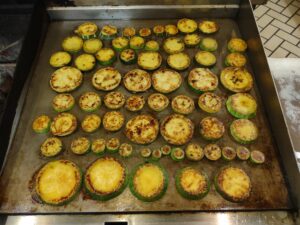
This report details our research efforts in 2023, the primary year of funding for the project, as well as some follow-up we did in 2024 and 2025. Some funding was allotted to the project in 2024 - for follow-up summer squash work and screen isolation cage research. The 2025 work is not funded but we are including some of it in the report so that readers may understand the ongoing trajectory of the work.
Cucurbita Moschata Summer Squash Trials (2023)
We conducted Cucurbita moschata summer squash trials at both Twin Oaks Seed Farm and Care of the Earth Farm. Moschata species summer squash are notable for their immunity to plectosporium blight and vine borers. Almost all summer squash in the U.S. are pepo species, but we found moschata summer squash varieties originating from Korea, Brazil, France and Italy to include in the trials. None of the varieties were affected by vine borer at either farm (Twin Oaks tends to have heavy pressure and Care of the Earth much lighter pressure).
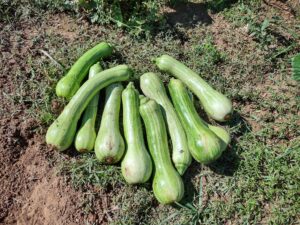
In the first succession at Twin Oaks (direct sowed May 25th), the most productive varieties were Teot Bat Put (an oval-shaped variety from Korea) and Longue de Nice (from France), followed by Menina Brasileira Precoce (Brazil), Tromboncino (Italy), Jin Dong Ae (Korea) and Mini Paulista (Brazil). The main problems encountered during the trial included squash beetle (Epilachna borealis) pressure and downy mildew. Longue de Nice had problems with blossom end rot. The squash beetle damage tended to be worse on the Korean varieties. In the second succession (direct sowed July 15th), Menina Brasileira Precoce was the most productive, likely due to its standout downy mildew resistance. The Korean summer squashes stood out for flavor in these trials, as did Mini Paulista. We also saved seed from many of the varieties, including the Korean hybrid varieties, for ongoing selection and breeding work; and we made crosses between Mini Paulista and several of the Korean varieties. Both moschata summer squash successions at Twin Oaks had five plants per block. See attached spreadsheets for yield data. Note that three entries were terminated early in the first trial, due to excessive squash beetle (Epilachna borealis) pressure at that end of the field.
Early Moschata Trial Twin Oaks
2023 Twin Oaks Late Moschata Trial
At Care of the Earth, the moschata summer squash trial was conducted under high downy mildew pressure, with a 6/28 planting date and rainy conditions that persisted until mid-August. “Tromboncino” was the best producer by count and by weight, although their shape and flavor are not ideal. We were also impressed by “Mini Paulista” and “Trombambino LOT 22-4901” (an unreleased variety from Michael Mazourek at Cornell University) as they were fairly productive, had some DM-resistance, and had better shape and flavor than “Tromboncino”; they are both vining. This trial had eight plants per block. See attached spreadsheet.
Moschata Summer Squash, Care of the Earth Farm
Cucurbita Pepo Summer Squash Trials (2023)
At Care of the Earth Community Farm, two Cucurbita pepo trials were conducted as part of this grant project.
The first (Pepo Trial 1) was transplanted out on 5/12/23. It included 5 plants each of 18 varieties, with a control (Gentry) repeated in three different locations in the bed. Plants were planted in one row at 1.5’ spacing. The 18 varieties included were: Crookneck Yellow Squash, Dark Star Zucchini, Early Golden Yellow Squash, Early Prolific Yellow Squash, Elite Zucchini, Golden Bush Scallop Squash, Gentry Yellow Squash, Goldini II Zucchini (had both yellow squash and yellow zucchini types present), Respect Zucchini, Tatume Squash, Yellow Crookneck Yellow Squash, “20-6” PI 612865, “20-7” PI 612866, “Calabaza de India” PI 442296, Calabaza de Manteca” PI 442321, “Ixchil” PI 449350, “Tzol” PI 615129, and “WC2122” PI 438700. It was particularly rainy in late May and early June with cooler than average temperatures and significant cloud cover. In the field, there was some early presence of spotted cucumber beetles (CB) (not significant), followed by heavy squash bug (Anasa tristis) pressure (the worst we have seen in 15 years here). Most varieties experienced Anasa wilt to some extent: Dark Star and Elite showed the most susceptibility, while 20-6, 20-7, Calabaza de India, Ixchil, and Tzol showed very significant resistance. A few of the varieties (Golden Bush Scallop and Gentry) showed susceptibility to Pythium Fruit Rot during the wettest period. Gentry also showed signs of Mosaic Virus starting in this period and continuing through the planting. Gentry continued to produce during this time and only marketable fruits were counted as part of production.
Harvest data as well as all other characteristics are detailed in Table “Pepo Trial 1.” The three most productive varieties calculated by pounds/100 square ft. were Respect, Elite, and Gentry (all hybrids). These three varieties are all bush plants, and their production was concentrated to the first month. However, each of these varieties as well as all the other zucchini and most of the other more common open-pollinated yellow squash varieties struggled later in the planting (late June through July) when pressure from Anasa tristis was high and Plectosporium blight (Plectosporium tabacinum) appeared. There were, though, several varieties that still produced through these stresses. Those varieties included: Yellow Crookneck, Calabaza de Manteca, Tatume, and WC-2122.
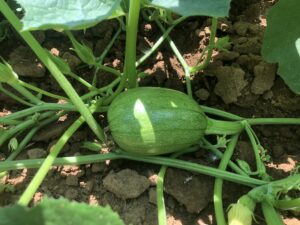
The second trial (Pepo Trial 2) was transplanted out on 6/28/23. It included 8 plants each of 17 varieties, with a control (Elite) repeated in three different locations in the bed. Plants were planted in one row at 1.5’ spacing. The 17 varieties included were: Crookneck Yellow Squash, Dark Star Zucchini, Early Golden Yellow Squash, Early Prolific Yellow Squash, Elite Zucchini, Gentry Yellow Squash, Goldini II Zucchini (had both yellow squash and yellow zucchini types present), Respect Zucchini, Tatume Squash, Yellow Crookneck Yellow Squash, “20-6” PI 612865, “20-7” PI 612866, “Calabaza de India” PI 442296, Calabaza de Manteca” PI 442321, “Ixchil” PI 449350, “Tzol” PI 615129, and “WC2122” PI 438700. There were average temperatures throughout the period. It was wet in late July and early August, followed by very dry conditions from mid-August through September. In the field, there was heavy Plectosporium blight present beginning the first week of August, followed by average DM pressure beginning in mid-August. In many ways, this trial was first and foremost a trial of which varieties could resist Plectosporium blight, and then of the survivors, which were also resistant to Downy Mildew.
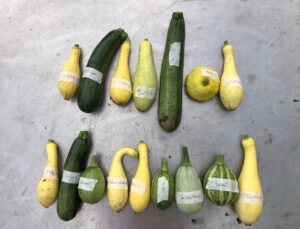
Harvest data as well as all other characteristics are detailed in Table “Pepo Trial 2.” The most productive variety was Tatume, followed by WC-2122, and Early Golden. Early Golden was the last of the commercially available zucchini/yellow squash still producing and was the most resistant to Plectosporium Blight of those varieties. However, it still eventually succumbed to it. The most resistant varieties to Plectosporium Blight were 20-6, 20-7, Calabaza de Manteca, Ixchil, Tatume, Tzol, and WC-2122 (in alphabetical order, with none being particularly more resistant than the other). (However, 20-6, 20-7, and Tzol are very late season and so were not producing during this period.) Amongst these Plectospoium blight-resistant varieties, the most resistant to Downy Mildew were Ixchil and Manteca, which both produced up until frost. Followed by Tatume and WC-2122, which showed good resistance to DM but eventually succumbed to it.
In conclusion, with insect and disease pressures common to our region (including Cucumber Beetles and Anasa wilt early, followed by Plectosporium blight in the middle of the summer, followed by Downy Mildew typically in the late summer), multiple varieties are needed for continued production. Although zucchini can be grown early, there is not an open-pollinated variety that we know of that performs well here. No zucchini (hybrid or open-pollinated) has resistance to Plectosporium blight, making it very difficult for zucchini to be grown past June in organic conditions. There are several yellow summer squash varieties that can be grown early. Gentry is the most productive; however, several of the o-p yellow summer squash (Early Prolific, Crookneck, Yellow Crookneck, and Early Golden) are also productive. Of these yellow squash only Early Golden has some resistance to Plectosporium blight, and it is not enough for it to be productive through the Plectosporium blight period. The only varieties that show sufficient resistance to Plectosporium blight are varieties that are not zucchini or yellow squash types and that are vining. Amongst these, Ixchil, Manteca, Tatume, and WC-2122 show at least some resistance to Downy Mildew, which is necessary later in the season (and in some seasons, as early as July). These varieties could be selected for earlier production, best disease resistance, and shortest vines. As is, they could work for farmers with more flexible planting schemes and in markets where consumers are willing to try something different. These varieties could also be used for breeding disease-resistant varieties by crossing with bush plants or varieties with fruit types that are easier to market (yellow straight or crookneck, zucchini, or perhaps most easily eight-ball types or cousa types). Their resistance to Plectosporium blight and Downy Mildew is invaluable.
Summer Squash Work in 2024 and 2025
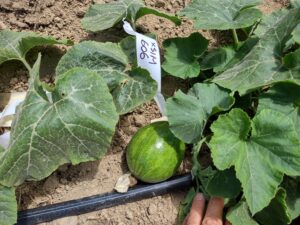
The decisions about how to move forward with summer squash work were somewhat complex. The Korean moschata varieties are early, grow on relatively compact plants, and have shapes that more closely resemble commercial pepo summer squashes. For these reasons, and because these varieties are hybrids, we chose to put energy at Twin Oaks Seed Farm into stabilizing several them as open pollinated varieties. Two of the Brazilian varieties, Mini Paulista and Menina Brasileira Precoce, showed promise in terms of disease resistance and acceptable productivity. We moved forward with these by simply producing seed and offering it through Common Wealth Seed Growers. Lastly, we felt that crosses between Mini Paulista and the Korean varieties have promise in terms of combining disease resistance with earliness and productivity, while maintaining a short vine growth habit. Crossing the Korean varieties with Menina Brasileira Precoce, and crossing Longue De Nice with Menina Brasileira Precoce could also lead to fruitful selection projects, but we have not pursued those projects to date. Tromboncino is also certainly a notable variety in terms of yield and vigor, but many seed companies offer it, and we found the flavor somewhat bland and the curved shape not optimal.
Among C. pepo varieties, Tutume was a standout for late season production, so we moved forward by comparing several different strains of Tutume at Care of the Earth Farm in 2024. We found very little difference between the strains, including in terms of productivity and disease resistance. We saved seed from a number of plants of different strains in that trial, and started selling the seed through Common Wealth Seed Growers.
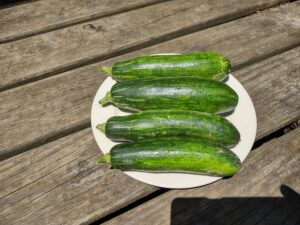
In 2024 at Twin Oaks Seed Farm we grew over 50 plants from the F2 Korean squash seeds saved in 2023: Jin Dong Ae, King Ka Ae, and Teot Bat Put. We attempted to self pollinate all of these plants, but only achieved about a 40% pollination success rate. Nevertheless we obtained seed from many good plants, with good shape and productivity. Jin Dong Ae and Teot Bat Put especially showed significant segregation in the F2 generation, with variation in shape and color. King Ka Ae F2 showed some segregation. In 2025 we are again selecting from these populations. This year, instead of hand pollination, we are time isolating the growouts in three different fields, where we are also producing moschata winter squash seed. To accomplish this, the Korean varieties were planted in late April, and the winter squashes were planted in early June. The Korean squash plants will be covered with screen cover for the duration of the season before the winter squash starts to flower. We are happy to be able to add this method as a tool for squash seed saving, in addition to pollination isolation cages and hand pollination.
In 2024 we also grew F1 seed from crosses between Mini Paulista and Jin Dong Ae and between Mini Paulista and Teot Bat Put, saving hand-pollinated seed from both populations to advance to the F2 stage. In 2025 we are growing and selecting from the F2 plants of both populations, using hand pollination for seed saving.
Squash Seed Production in Pollination Isolation Cages
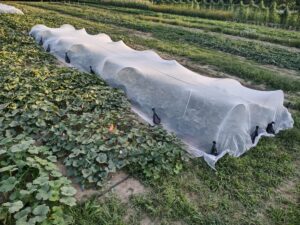
In 2023 at Twin Oaks Seed Farm we used pollination isolation screen cages for the first time, with three separate winter squash seed production growouts. This allows us to save seed from several varieties growing in the same field without having to hand pollinate. (Hand pollination is very labor intensive and doesn’t work for some varieties.) We used a “meso tunnel” design that we learned about from “The Current Cucurbit” project out of Iowa State. Meso means mid height, as opposed to low or high tunnels - these are made out of 1⁄2 inch x 10 foot metal conduit bent with a hoop bender to create hoops that are about 3.5 feet tall. The hoops are arranged in two rows, and covered with a 20 foot wide “Protecnet” screen cover, to create cages 11 feet wide by 50 feet long, suitable for 15-20 fully vining squash plants. We bought small bumble bee hives from a Michigan-based company called Plant Products Inc, which were successful in pollinating the squash in the cages. The Protecnet (25g weight) was purchased from Dubois Agrinovation, a Canadian company. We got good harvests from all the cages. Seedstocks produced were “Choctaw Sweet Potato,” and two different selections of Cuban Neck Pumpkin made at Twin Oaks Seed Farm in 2015 and 2019. We’re excited to have this tool available for future seed saving and plant breeding projects – it means we’ll be able to grow many more varieties in any given year. The meso tunnel design was cheaper than the caterpillar tunnels we had envisioned when we submitted our project proposal. For this reason we had extra funds that were able to use to create several additional tunnels in 2024, for use at both Twin Oaks Seed Farm and Care of the Earth Community Farm.
In 2024 we purchased material to make several more tunnels. At Twin Oaks Seed Farm we were successful in producing seed for Guatemalan Green Ayote, Jamaican Tropical Pumpkin, Chinese Tropical Pumpkin, and Cuban Neck Pumpkin. The process did not go as smoothly as in 2023 however. The first problem was that the weather was extremely hot when we ordered bumble bee hives, and most of the bees died during the shipping process. Hives are shipped overnight, but this is not reliable coming to our location, compounding the problem. Plant Products Inc. sent a new shipment of bees (without charge) and these arrived in better condition. However, many of the bees did not venture out of their hives, possibly due to ongoing hot weather or trauma from shipping. As a result pollination was not robust in some of the cages.
In 2024 Care of the Earth Farm did seed production of four varieties in pollination isolation cages: WC2122 (PI 438700), Manteca (PI 442321), Yellow Crookneck, and Ixchil (PI 449350). It was an extremely wet year on the farm, and the screen covers retain some extra moisture, compounding the problem. Yellow Crookneck was not successful because it succumbed to plectosporium. Pollination / fruit set was poor on the other three varieties, though they did yield enough seed for replanting.
Overall we have a mixed assessment of the screen cage isolation cage method for squash. We clearly demonstrated that it can work, but there are drawbacks, especially in terms of handling the bees. In 2025 we are focusing on using isolated fields as well as time isolation (doing early and late plantings of two seedstocks in each field, covering the early-planted one after it sets fruits and before the late-planted one starts to flower). We will also be doing some hand pollinated growouts. We do expect to use the screen cage isolation method again in the future, and for plant breeders and seed savers without access to multiple isolated fields it could be especially useful. The type of netting is another important consideration. Although Protecnet worked well it isn’t very durable, and probably can’t be used for reliable isolation for more than two seasons. There is a different kind of insect netting that is woven and not knitted and is much more durable. We just purchased some from Growers Nursery Supply in Oregon. We are using it for pepper isolation cages in 2025 and will probably use that in the future for squash isolation cages.
Winter Squash Breeding Trials at Twin Oaks Seed Farm
South Anna x (South Anna x Chinese Tropical Pumpkin): We grew approximately 120 plants in 2023, allowing them to intertwine but tracing the fruits back to the vines for most of them. In this project we’re especially emphasizing keeping quality, in addition to eating quality and productivity. We evaluated keeping quality for fruits from 23 plants in early January, and eating quality for 11 after that (with brix, dry matter, and eating tests). We were happy with the characteristics of the plants in the plot as a whole, but also selected seven stand-outs to grow in 2024, and started selling sample seeds from these plants under the name Bakers Branch Butternut. This growout was isolated from other moschata-species squash, so no hand pollination or isolation cages were employed. Though unfunded, we did a similar growout in 2024 and have another one planted in 2025.
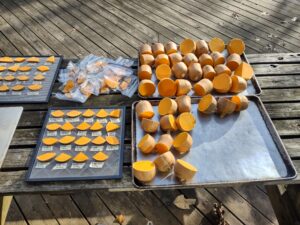
South Anna: In 2023 we traced back fruits to over 120 plants, placing the fruits at the base of each plant. The best 40 plants (in terms of yield and appearance) were weighed and further evaluated for keeping quality and eating quality. We are especially aiming to improve keeping quality and yields of the variety. This growout was isolated from other moschata species squash, so no hand pollination or isolation cages were employed. Squash Beetles (Epilachna borealis) were especially bad in this field, somewhat impacting yields and quality. Though unfunded, we did a similar growout in 2024 and have another one planted in 2025. We are seeing improvement in the variety due to this intensified selection work (we have been selecting the variety since 2014, some years more and some years less intensively). Eating quality is excellent, as is disease resistance; and we are seeing good progress in keeping quality and productivity.
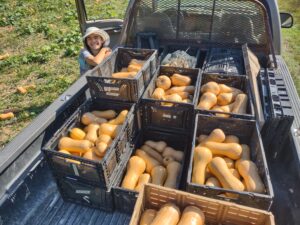
South Anna x (South Anna x Guatemalan Green Ayote): In 2023 grew 22 plants from three 2022 selections of this population. Each plant was separately trained and self-pollinated, and then evaluated for yield, foliage resistance to downy mildew, keeping quality and eating quality. What we’re going for with this population is a dual purpose squash that has tender seeds for roasting as well as excellent dessert eating quality – plus downy mildew resistance, good yields and good keeping quality. Four plants stood out for all these categories. In 2024 we grew several selections in an isolation cage, and one of the selections alone in a 4-plant block. It is one of these plants that stood out during evaluation, and we were fortunate to have self-pollinated it. This selection has 2-pound round fruits. We are growing an 8-plant block in 2025 for further assessment.
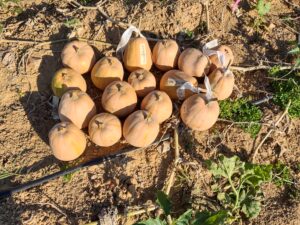
Moranga Coroa x Winter Sweet: This is a maxima-species breeding project, and the main goal is development of vine borer resistant plants with excellent flavor. Note that moschata-species varieties, which we mostly work with, are naturally vine borer resistant, but that maximas generally are not. In 2023 we grew 54 plants from seven 2022 selections. The overall rate of plants not affected by vine borer was 39%, but one of the selections had 68% unaffected plants. We did eating and keeping quality evaluation on fruits from the best vine borer resistant plants. In 2024 we decided that self pollination was necessary to isolate the good eating quality traits; we grew and self pollinated 25 plants, and are now moving forward with four of the selections in 2025.
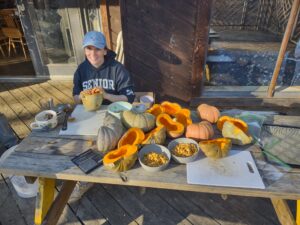
Guatemalan Green Ayote: This variety came to us with less than 10% of squash exhibiting deep green interior color. In 2020 breeding trials we identified and self pollinated one plant with deep green color and several with some green interior color. The plant with deep green color was later and less productive, so we crossed it to one of the lighter green plants and went from there with the breeding and selection. In 2023 however, we grew some of the uncrossed dark green seedstock and were impressed with its productivity, color, and flavor, and with the fact that it was not later than the crossed seedstock (which was still significantly less green). For this reason we are switching to working with the pure deep green selection moving forward. In 2024 we grew this seed in a pollination isolation cage, but pollination and fruit set were low due to problems with the bumble bees (see isolation cage section below). In 2025 we are growing the variety in an isolated field.
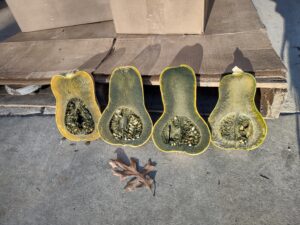
Chinese Tropical Pumpkin: We grew 11 plants in 2023, self pollinating and evaluating each one separately for productivity, eating and keeping quality, as well as fruit shape. Four plants stood out for replanting. In 2024 we grew these selections together in an isolation cage, but it became clear that two of them were much better than the others. In 2025 we are going back to those two 2023 selections and growing them together in an isolated field.
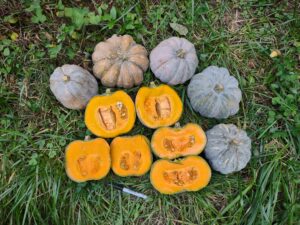
Cuban Neck Pumpkin: In 2023 we evaluated fruits from 26 plants grown in two different isolation cages - for keeping quality, eating quality, appearance, productivity, and lack of splitting. The reason for two separate cages is that we had two prior selections that we didn’t want to cross. Indeed, one of them clearly had better flavor. We grew selections from this in an isolation cage in 2024, and are planting them in an isolated field in 2025.
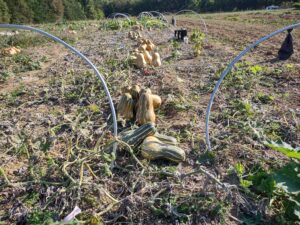
Cuban Neck Pumpkin x South Anna and JWS 6823: This is a population we created over many years. In 2023 we grew five plants, hand pollinating several of them. They stood out for productivity, and we selected the plant with the best keeping quality and eating quality to move forward with in 2024. In 2024 we grew and self pollinated eight plants. One stood out for excellent flavor as well as productivity. However this line in general appears to have below average keeping quality.
In 2023 we also trialed some new varieties from Brazil, including Pataca Gigante, Moranga Exposiciao, Mini Abobora Aura Rosa, a new seedstock of Moranga Coroa, Majestade, and Goaninha. Moranga Exposiciao (a C. maxima variety) stood out for its vine borer resistance (4/4 plants were resistant). It has a beautiful deep orange color but bland flavor. The new Moranga Coroa seedstock however (from ISLA Seeds, also a maxima) showed only 2/4 plants resistant. We still have Moranga Coroa seedstock derived from seeds we got from KCB Samen in 2018. These showed better resistance (4/4) but unfortunately our population went through a 1-plant genetic bottleneck that has negatively affected fruit size and productivity. Goaninha (a C. moschata squash) had very good flavor, brix and dry matter, as well as good downy mildew resistance.
Following is a spreadsheet with brix, dry matter, keeping quality, yield, and flavor evaluation data for many of the squash evaluated at Twin Oaks Seed Farm in 2023.
2023 Winter Squash Eating Quality Spreadsheet - Twin Oaks
Breeding and Selection of Xiye Butternut and Ofelia Butternut at Care of the Earth Farm
In 2023, we evaluated 20 individual plants in each of 8 different Xiye Butternut gene pools, evaluated 100 individual plants of our main breeding line, and did seed growouts. In the Xiye gene pool comparison, we kept data on vine length, downy mildew resistance, fruit type, consistency of fruit type, and productivity, flavor and storability. Our intention with these growouts is to better understand the connections between plant and fruit phenotypes and storage and flavor profile. In the larger evaluation, we kept data on vine length, downy mildew resistance, fruit type, consistency of fruit type, and productivity in order to inform self and cross pollinations and for ongoing selection work. Although we continue to select for a more uniform squash, we also want to maintain several more diverse gene pools for climate resiliency and for future breeding. We were again very impressed with Xiye’s DM-resistance and productivity even in a challenging season.
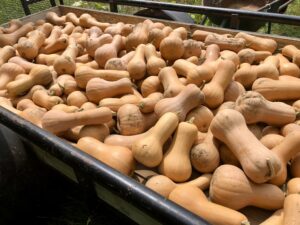
We also evaluated 180 individual plants of Ofelia (a smaller sister variety of Xiye) for vine length, downy mildew resistance, fruit type, consistency of fruit type, and productivity. We were surprised by the uniformity of the plants across evaluation criteria. They were quite productive and showed good DM-resistance. We also really liked their size, right under 3#. We made several self-pollinations and cross-pollinations and hope to improve neck thickness, depth of flavor, and keeping quality in 2024.
In 2024, we continued hand-pollination of Xiye and Ofelia, as well as an off-shoot selection of Xiye (XIYETN). With Ofelia population, we were selecting for squash with thicker necks and more traditional butternut shape. With Xiye, we were selecting for higher dry matter content and Brix above 10.5 as well as 4-5# and butternut shape. Both populations continue to show good resistance to DM and high productivity. The XIYETN population is a selection from a few similar plants from 2023 that were highly productive and had thicker necks (TN) than the original Xiye. Further selections were made from them in 2024. In 2025, Xiye is being grown out for seed, with some hp selections made on most productive plants. Ofelia is being grown out for seed, with some hp selections on best shape. We are also growing out 4 different selections of XIYETN from 2024. We are just starting hand-pollination on those.
Educational & Outreach Activities
Participation summary:
Our outreach consisted of instagram posts about the project (nine posts); a report on the project in Common Wealth Seed Growers' 2024 print catalog; a report in Common Wealth Seed Growers' 2025 print catalog; 2023 and 2024 Common Wealth Seed Growers end-of-season email newsletters (approximately 2000 recipients); an interview with Edmund Frost about squash research in Farm Show magazine; a podcast episode for "Voices from the Field" (produced by ATTRA and SARE); multiple farm/project tours (August 2023, August 2024, September 2024 at Twin Oaks Seed Farm), and one field day at Care of the Earth Community Farm in July, 2024.
Learning Outcomes
Learned new seed saving techniques (using pollination isolation cages)
Gathered information on varieties and seedstocks relavent to ongoing breeding efforts
Improved selections in ongoing breeding and selection projects
Became aware of new variety options to address production challenges
Project Outcomes
The benefits of regional plant breeding and selection manifest over a time scale that is somewhat longer than the duration of this project. Nevertheless, we made significant progress in the following ways:
-Identifying promising squash varieties and seedstocks previously unknown or little-known in our region, and making them available to farmers and gardeners via the Common Wealth Seed Growers website. This includes Mini Paulista Summer Squash, Menina Brasileira Precoce Summer Squash, and Tutume Summer Squash.
-Making progress in 10 winter squash breeding, selection, and variety improvement projects; and starting several new summer squash breeding and selection projects. Many of the winter squash are available for purchase through Common Wealth Seed Growers. Varieties we offer that were improved through this project include South Anna Butternut, Chinese Tropical Pumpkin, Guatemalan Green Ayote, Cuban Neck Pumpkin, and Xiye Butternut. New releases include Bakers Branch Butternut. We also are offering "research samples" from several in-progress breeding projects, including the Korean summer squash dehybridization efforts (Jin Dong Ae, King Ka Ae, and Teot Bat Put), and our Vine Borer Resistant Kabocha breeding project.
-Successfully piloting squash seed saving in pollination isolation cages with introduced bumble bee pollinators.
-Gathering variety information that can be of use to other plant breeders and seed stewards in our region.